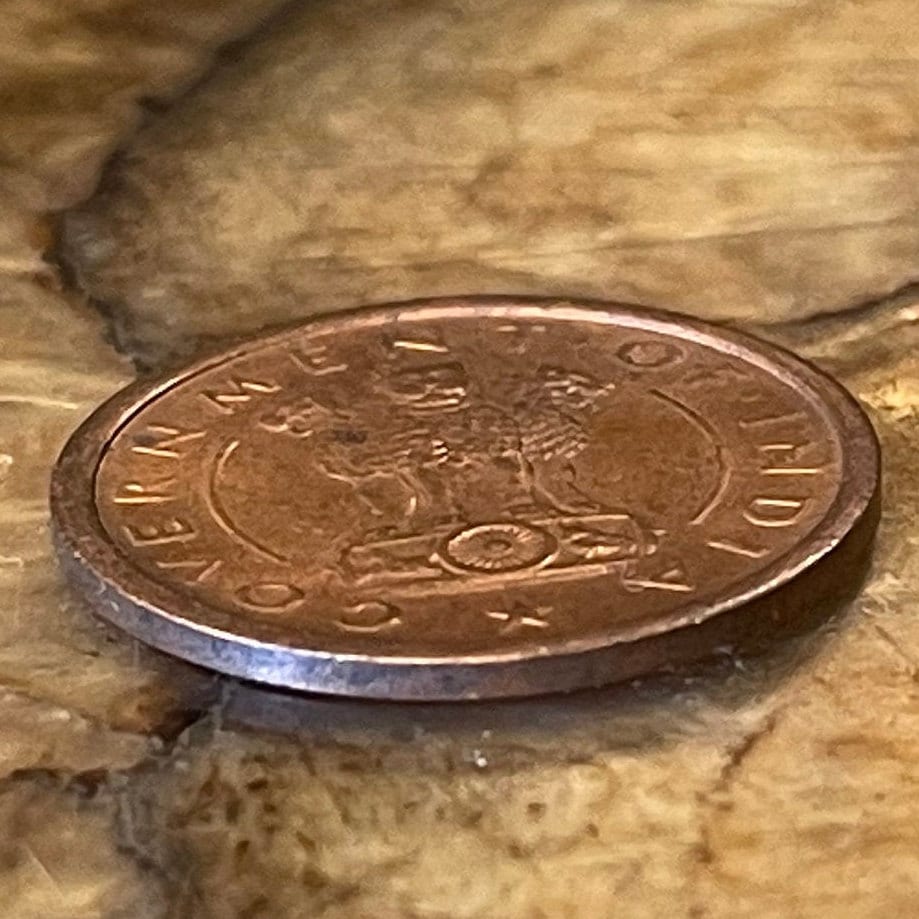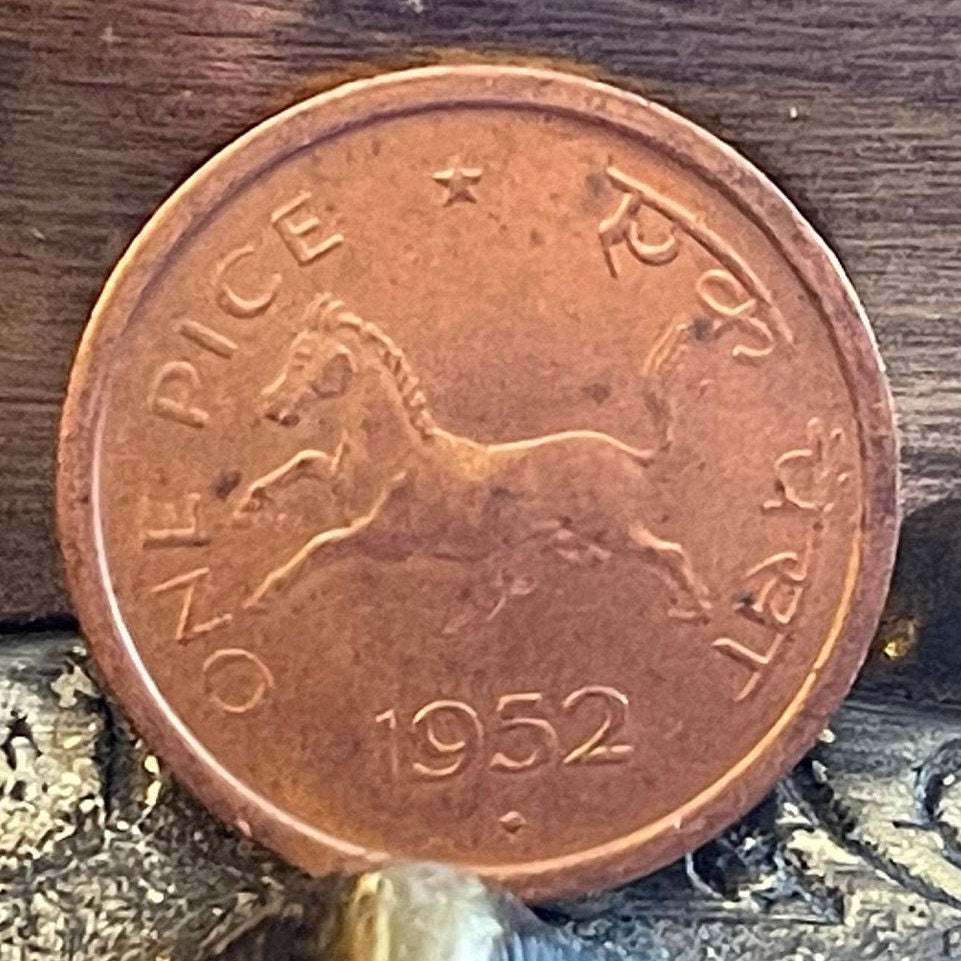elemintalshop
Manipuri Pony & Ashoka Capitol 1 Pice India Authentic Coin Money for Jewelry and Craft Making (Horse) (Polo Pony)
Manipuri Pony & Ashoka Capitol 1 Pice India Authentic Coin Money for Jewelry and Craft Making (Horse) (Polo Pony)
Couldn't load pickup availability
Manipuri Pony & Ashoka Capitol 1 Pice India Authentic Coin Charm for Jewelry and Craft Making (Horse) (Polo Pony)
Obverse: Ashoka Lion Capital
Lettering: GOVERNMENT·OF·INDIA
Reverse: Manipuri Pony facing left
Lettering: ONE PICE * एक पैसा
Translation: One Pice One Pice
Features
Issuer India
Period Republic (1950-date)
Type Standard circulation coin
Years 1950-1955
Value 1 Pice (1/64)
Currency Rupee (1950-1957)
Composition Bronze
Weight 2.92 g
Diameter 21 mm
Thickness 1.14 mm
Shape Round
Technique Milled
Orientation Medal alignment ↑↑
Demonetized 1 April 1957
Number N# 1627
References KM# 1
Wikipedia:
The Manipuri Pony is a traditional Indian breed of small horse or pony from Assam and Manipur in north-eastern India. It appears both in the history and the mythology of Manipur, and was used for warfare. It is believed to have been the polo pony in use in Assam in the mid-nineteenth century when British tea planters first saw polo being played, and the height limits set for polo ponies were based on ponies of this breed. It was very numerous in the early twentieth century, but numbers have since fallen. A breed society was established in 1977, and a breed standard was drawn up by the Indigenous Horse Society of India in 2009.
History
Small horses have been bred for centuries in the Manipuri area of north-eastern India. They were often used as warhorses, and were ridden by the Meitei warriors of Kangleipak (later called Manipur). Horses from Manipur were used by the cavalry of Gharib Newaz in his wars against the Konbaung dynasty of Burma. When the game of polo was first observed by British tea planters in Assam, these are believed to have been the polo ponies that were being used. Some unsuccessful attempts were made to cross-breed the Manipuri polo ponies with Arab stock. The height of polo ponies was based on the average height of the Manipuri, and was at first restricted to 132 cm (13 hands), later relaxed to 136 cm (13 h); in 1916 the restriction was completely removed. At about this time the export of ponies from Manipur was banned in order to allow breed numbers to recover. Manipuri horses were used to transport British troops into Burma during the Second World War.
In 1977 a breed society, the Manipur Horse Riding and Polo Association, was established. In recent years, breed numbers have decreased, and estimates place the breed at somewhere between 2300[5] and 1000 in population in the 21st century. Population numbers continue to dwindle in part due to high numbers of ponies being smuggled into Myanmar (Burma), where the breed is in demand, after either having been purchased or stolen from their Indian owners. In 2005, a heritage park was opened by the Manipur Horse Riding and Polo Association with the goal of preventing the extinction of the breed and promoting them to tourists.
Characteristics
The Manipuri Pony has a light head with a straight profile, set on a well-formed neck, somewhat pronounced withers, a deep chest and sloping shoulders. The croup is sloping, the legs sturdy and the hooves well-proportioned. The overall appearance is elegant. Manipuri ponies generally stand 11 to 13 hands (44 to 52 inches, 112 to 132 cm) high.[9] They are often bay in color, but can also be pinto, grey and chestnut.[10] Because of the short height of the ponies, riders use shortened mallets while playing polo. The Manipuri pony resembles, and is distantly related to, the Burmese Pony and the Indonesian Batak and Sumba ponies.
In 2007, a study was published that examined genetic variation among five Indian equine breeds—the Manipuri, Marwari, Spiti, Bhutia, and Zanskari. Based on analysis of microsatellite DNA, the Manipuri was found to have the greatest genetic distance from the Marwari, and a much closer genetic distance to the other three breeds. The distance from the Marwari was not only genetic, but seen in physical characteristics, particularly height and environmental adaptability. The physical differences were attributed to differing ancestries: the Marwari horse is closely associated with the Arabian, while the four other breeds are thought to have descended at least in part from the Tibetan pony. None of the breeds in the study were found to be closely genetically associated with the Thoroughbred.
Uses
Polo was introduced into the area of Manipur state as early as the seventh century, and Manipuri ponies were one of the first breeds used in the game. The British learned of polo during the nineteenth century while watching it played on Manipuri ponies in India. The breed is still used for polo today in India, but other breeds are more popular in Europe and America. Manipuri ponies are often also used to play sagol kangjei, a version of polo believed to be close to what was originally played when the sport was invented. Sagol kangjei is more demanding than modern polo, as ponies are used for the entire match instead of being changed between periods. Manipuri ponies are also used for racing. During their early history, they were in demand as cavalry horses, and men that rode these ponies were thought well-mounted.
***********
Wikipedia:
The Lion Capital of Ashoka is a sculpture of four Asiatic lions standing back to back, on an elaborate base that includes other animals. A graphic representation of it was adopted as the official Emblem of India in 1950. It was originally placed on the top of the Ashoka pillar at the important Buddhist site of Sarnath by the Emperor Ashoka, in about 250 BCE during his rule over the Maurya Empire. The pillar, sometimes called the Aśoka Column, is still in its original location, but the Lion Capital is now in the Sarnath Museum, in the state of Uttar Pradesh, India. Standing 2.15 metres (7 feet) high including the base, it is more elaborate than the other very similar surviving capitals of the pillars of Ashoka bearing the Edicts of Ashoka that were placed throughout India several of which feature single animals at the top; one other damaged group of four lions survives, at Sanchi.
The capital is carved out of a single block of polished sandstone, and was always a separate piece from the column itself. It features four Asiatic Lions standing back to back. They are mounted on an abacus with a frieze carrying sculptures in high relief of an elephant, a galloping horse, a bull, and a lion, separated by intervening spoked chariot-wheels. The whole sits upon a bell-shaped lotus. The capital was originally crowned by a 'Wheel of Dharma' (Dharmachakra popularly known in India as the "Ashoka Chakra"), with 32 spokes, of which a few fragments were found on the site. A 13th-century replica of the Sarnath pillar and capital in Wat Umong near Chiang Mai, Thailand built by King Mangrai, preserves its crowning Ashoka Chakra or Dharmachakra. The wheel on the capital, below the lions, is the model for the one in the flag of India.
Share










as described, coin in good shape. I am using it for a craft project.
Perfect, nice high relief
The coin is a cute one, and came nicely packaged. Will be buying more coins from this seller.
5 stars review from Dawn
5 stars review from Amber









